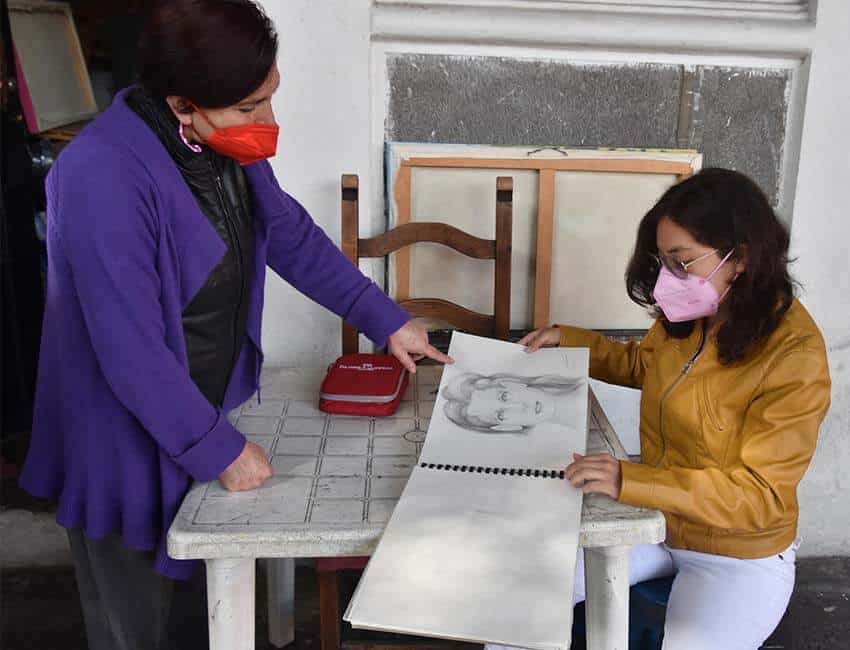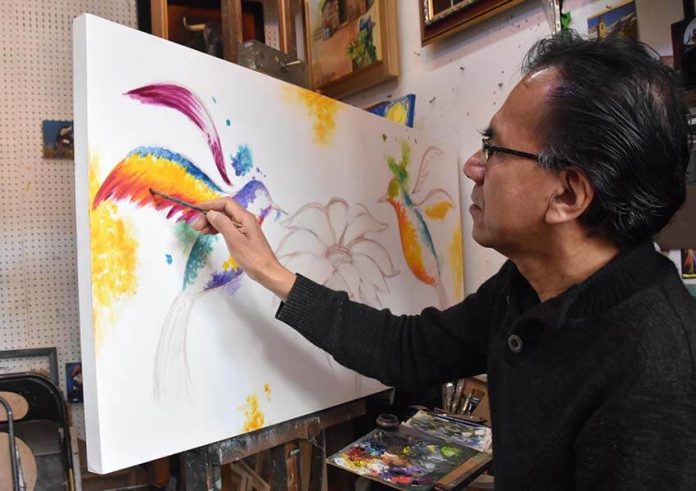Puebla city is probably not the first place you think of when listing off the world’s venerable old artists’ quarters, but the Puebla state capital’s Barrio del Artista (artist’s neighborhood) has been going strong for over 80 years, a small but cohesive community of creatives ever since it was founded by a pair of brothers.
Artists José and Ángel Márquez Figueroa raised the idea of creating an artists’ neighborhood in the city back in 1940 while holding outdoor classes in an area known as El Parián. José asked his students if they’d like to have an area in the city dedicated to artists and, of course, they all did.
After several months of effort, they secured a meeting with then-governor Gonzalo Bautista Castillo, who agreed that it was a good idea. Mayor Juan Manuel Treviño gave them a location at Calle 8 Norte, Esquina 4 Oriente, and the artists soon formed the Union of Plastic Arts of Puebla, an artists’ collective. The union held its first exhibit on May 5, 1941.
Eighty years later, the Barrio, the gallery and the union — now named the Union of Plastic Artists of Puebla of the Artist’s Neighborhood — are all still in existence, despite the fact that most of the union’s members are painters. “Two are sculptors and three are musicians,” Laura Díaz Heredia, the union’s secretary, said.
Díaz herself is a painter who specializes in portraits — “I like the expressions in portraits,” she said — but she also works as a sculptor, restores a variety of artwork and, like most of the artists there, gives classes.

She’s apparently an excellent and influential teacher. María Fernanda Castañeda Coiro, a preschool educator who, after studying with Díaz for four months, said she’d consider a career change. “If I have the opportunity, I would like to work as an artist,” Castañeda said.
The Barrio occupies a plaza that’s a block long. “There are 43 workshops,” Díaz explained. “Everyone in the Barrio is a member [of the union], and we are 38 members.”
One of the studios in the Barrio is used for a café, two are used to give courses and two are called the Rincón Histórico (historic corner), where photographs of the Barrio’s early years are on exhibit. The first one is a photograph of the extraordinary group of artists who exhibited in 1962.
In May of that year, a gallery named for José Luis Rodríguez Alconedo, a painter and revolutionary who was executed in 1815 for his antigovernment actions, opened on the second floor of one of the buildings in the neighborhood. Its exhibit featured some of Mexico’s most famous artists, including Diego Rivera, Frida Kahlo and Rufino Tamayo.
So it’s perhaps not surprising that becoming a member of the Barrio is no easy feat.
“There is an exam to get in,” Díaz said. “An artist must show the type of work, the way one works. It is a process that takes several years. It is a little difficult to join, yes. It is not impossible but it is hard.”

There are many benefits to having a studio here and being part of the union, she said. “[It] is to know other artists, to share knowledge, to talk about problems and to talk about art,” she said.
A couple of doors down from Díaz’s studio, Julian Villalobos Pérez was putting the finishing touches on a painting. Most of his work depicts Mexican pueblos.
“My technique is applying oil paint with a spatula,” he said. But he doesn’t always paint on a canvas. “I paint on papel amate,” he said, “a pre-Hispanic paper from San Pablito,” a pueblo in the Puebla municipality of Pahuatla.
Papel amate is made by pounding the boiled bark of fig or mulberry trees into a pulp. The resulting sheets are then traditionally dried in the open air. The process yields a paper that’s uneven, filled with ridges and bumps, something that Villalobos likes.
“It is very pretty to work with this paper,” Villalobos said. “It gives the painting more texture. It is more original to use this paper. It gives a different effect.”
Alberto Gómez Sánchez specializes in painting still lifes and is very clear about why he’s chosen a career as an artist. “The attraction for art is that I feel free,” he said. “It is one of the parts I like best, the freedom. No boss, no business. I do it to express my thoughts, ideas and feelings.”
He’s also a guitarist and the director of the José Luis Rodríguez Alconedo Gallery. “I like to direct events, to organize them,” he said. “We have a variety of art: painting, photography, sculpture. Many times, the exhibits are of people from outside. Part of my role is to bring in artists from outside.”
The gallery has a large number of exhibits annually. “We usually have 15 exhibits a year for members,” said Díaz, “[and] 30 for invited artists.” In addition to exhibits in the gallery here, the union also mounts exhibits in other Mexican states.
Like everywhere in the world, the Barrio del Artista was impacted by COVID-19. “With the pandemic, there have been some challenges,” said Gómez. “Last year, we were closed completely and we all worked from home. We were closed from April 2019 through February 2020 — 10 months.”
Tourists have been slowly trickling back to the area, and business, although still a little slow, has been picking up.
The Barrio del Artista is a great place to spend a couple of hours. In addition to the wide range of art on display in the studios and the gallery — and an opportunity to talk with artists about their work — the area boasts several restaurants and coffee shops. There are a number of large trees shading benches and inviting visitors to take a break from the hustle and bustle of daily life to sit with a cup of coffee and enjoy some art.
• To find out more about the Barrio del Artista and its offerings, you can visit their Facebook page or email them at uapac@barriodelartista.org.
Joseph Sorrentino, a writer, photographer and author of the book San Gregorio Atlapulco: Cosmvisiones and of Stinky Island Tales: Some Stories from an Italian-American Childhood, is a regular contributor to Mexico News Daily. More examples of his photographs and links to other articles may be found at www.sorrentinophotography.com He currently lives in Chipilo, Puebla.
